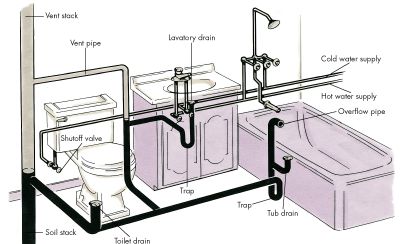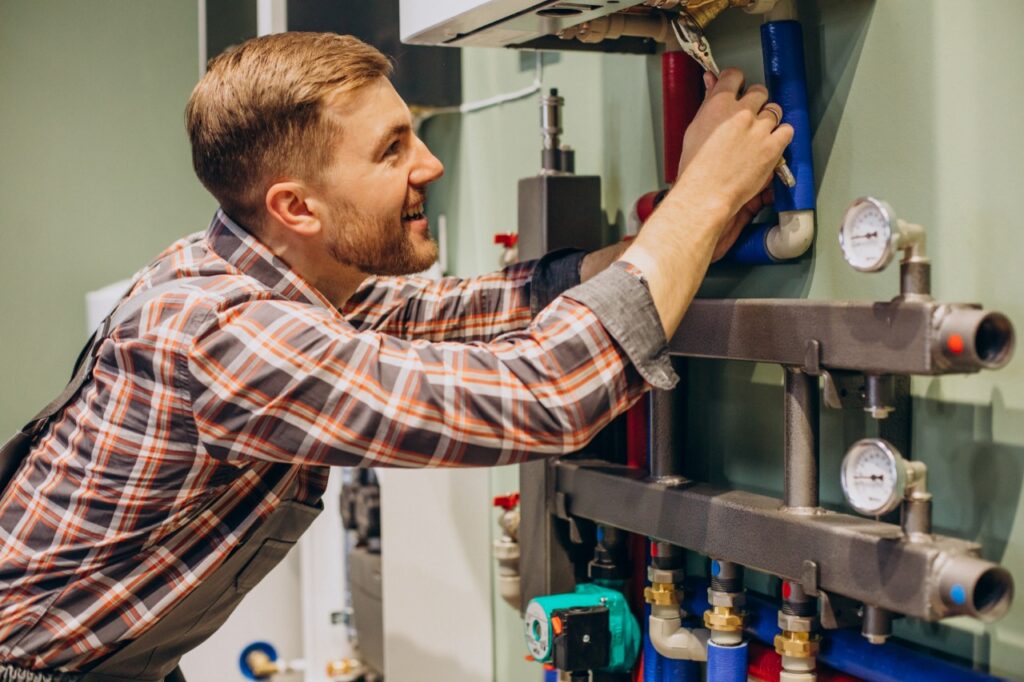Do you find yourself trying to locate selective information around Anatomy of a House: Understanding the Components?

Recognizing exactly how your home's pipes system works is vital for every homeowner. From delivering clean water for alcohol consumption, cooking, and bathing to securely removing wastewater, a properly maintained plumbing system is important for your family members's health and wellness and comfort. In this thorough guide, we'll discover the complex network that composes your home's pipes and offer ideas on maintenance, upgrades, and taking care of typical concerns.
Introduction
Your home's pipes system is more than just a network of pipelines; it's a complex system that ensures you have accessibility to tidy water and reliable wastewater removal. Recognizing its parts and just how they work together can assist you stop expensive fixings and ensure whatever runs efficiently.
Standard Components of a Plumbing System
Pipes and Tubing
At the heart of your pipes system are the pipelines and tubing that carry water throughout your home. These can be constructed from numerous materials such as copper, PVC, or PEX, each with its advantages in terms of longevity and cost-effectiveness.
Components: Sinks, Toilets, Showers, etc.
Fixtures like sinks, toilets, showers, and tubs are where water is utilized in your house. Recognizing just how these components link to the pipes system assists in identifying troubles and intending upgrades.
Shutoffs and Shut-off Factors
Shutoffs regulate the circulation of water in your pipes system. Shut-off shutoffs are essential throughout emergency situations or when you need to make repair services, permitting you to isolate parts of the system without disrupting water circulation to the entire home.
Water System System
Key Water Line
The main water line connects your home to the local water or a private well. It's where water enters your home and is distributed to different fixtures.
Water Meter and Pressure Regulator
The water meter actions your water use, while a stress regulator makes certain that water moves at a secure pressure throughout your home's pipes system, avoiding damage to pipes and fixtures.
Cold Water vs. Hot Water Lines
Comprehending the difference between cold water lines, which supply water straight from the main, and hot water lines, which bring heated water from the hot water heater, assists in repairing and preparing for upgrades.
Drainage System
Drain Pipes Pipeline and Traps
Drain pipes bring wastewater far from sinks, showers, and toilets to the drain or septic system. Catches prevent drain gases from entering your home and likewise trap particles that might trigger obstructions.
Ventilation Pipes
Air flow pipelines allow air into the drain system, protecting against suction that can slow drainage and trigger traps to vacant. Correct ventilation is necessary for preserving the stability of your pipes system.
Relevance of Proper Drain
Making sure appropriate water drainage avoids backups and water damage. Consistently cleansing drains pipes and keeping traps can stop pricey fixings and expand the life of your pipes system.
Water Heating Unit
Kinds Of Water Heaters
Water heaters can be tankless or conventional tank-style. Tankless heating units warm water on demand, while tanks store heated water for instant use.
Just How Water Heaters Attach to the Pipes System
Understanding how water heaters connect to both the cold water supply and warm water circulation lines assists in identifying issues like not enough hot water or leaks.
Maintenance Tips for Water Heaters
Consistently purging your water heater to remove sediment, inspecting the temperature level setups, and inspecting for leakages can expand its life-span and boost power efficiency.
Usual Plumbing Issues
Leaks and Their Causes
Leaks can occur as a result of maturing pipes, loose fittings, or high water stress. Dealing with leaks promptly avoids water damage and mold growth.
Clogs and Blockages
Clogs in drains pipes and commodes are commonly triggered by purging non-flushable things or a build-up of oil and hair. Using drain screens and bearing in mind what decreases your drains can stop obstructions.
Indications of Plumbing Issues to Look For
Low water pressure, slow drains, foul odors, or unusually high water expenses are indications of prospective plumbing problems that ought to be dealt with immediately.
Plumbing Maintenance Tips
Routine Evaluations and Checks
Arrange yearly plumbing assessments to capture concerns early. Look for signs of leaks, rust, or mineral build-up in faucets and showerheads.
DIY Upkeep Tasks
Straightforward tasks like cleaning tap aerators, looking for toilet leaks utilizing color tablets, or protecting revealed pipes in cold climates can stop significant plumbing problems.
When to Call a Specialist Plumbing
Know when a pipes concern calls for expert proficiency. Attempting intricate repair services without appropriate expertise can bring about even more damages and greater repair service expenses.
Updating Your Pipes System
Reasons for Upgrading
Upgrading to water-efficient fixtures or replacing old pipes can boost water top quality, lower water costs, and raise the worth of your home.
Modern Pipes Technologies and Their Benefits
Explore modern technologies like clever leakage detectors, water-saving commodes, and energy-efficient hot water heater that can save cash and decrease environmental influence.
Expense Factors To Consider and ROI
Determine the upfront prices versus long-lasting cost savings when thinking about pipes upgrades. Lots of upgrades pay for themselves via decreased energy expenses and fewer repairs.
Ecological Impact and Preservation
Water-Saving Components and Home Appliances
Setting up low-flow taps, showerheads, and bathrooms can dramatically minimize water use without compromising efficiency.
Tips for Reducing Water Usage
Basic practices like dealing with leakages promptly, taking shorter showers, and running full loads of washing and dishes can preserve water and reduced your energy costs.
Eco-Friendly Plumbing Options
Consider lasting plumbing materials like bamboo for floor covering, which is durable and green, or recycled glass for countertops.
Emergency Readiness
Steps to Take Throughout a Pipes Emergency
Know where your shut-off shutoffs are located and just how to shut off the supply of water in case of a ruptured pipeline or major leak.
Importance of Having Emergency Situation Contacts Helpful
Keep get in touch with info for neighborhood plumbers or emergency solutions easily available for quick response during a pipes crisis.
Do It Yourself Emergency Fixes (When Relevant).
Short-term fixes like using duct tape to patch a leaking pipe or placing a bucket under a trickling faucet can decrease damage up until an expert plumbing professional shows up.
Verdict.
Recognizing the anatomy of your home's pipes system empowers you to maintain it efficiently, conserving time and money on fixings. By adhering to regular maintenance regimens and staying notified concerning modern-day pipes technologies, you can ensure your plumbing system runs efficiently for many years ahead.
The Anatomy of Your Home s Plumbing System
Understanding the anatomy of your home s plumbing system is essential for any homeowner. It not only helps in identifying potential issues but also facilitates effective communication with professionals when repairs or upgrades are needed. Your home s plumbing system is more than just pipes and faucets; it s a complex network that ensures the efficient and hygienic flow of water in and out of your house. In this blog, we ll dissect the crucial components of your home s plumbing system. For those in Antelope Valley, Brock Plumbing is your trusted partner for all your plumbing needs, ensuring your system functions smoothly and efficiently.
Water Supply System
Main Water Line: This is where your home s plumbing system begins. The main water line connects your home to the public water supply or a private well. Pipes and Shut-off Valves: Pipes distribute water throughout your home. Shut-off valves are crucial for controlling the flow of water and making repairs without shutting off the entire system. Drainage System
Drain Pipes: These pipes carry waste and water away from sinks, toilets, and showers. Vents: Vents allow sewer gases to escape and help maintain proper pressure in the drainage pipes, ensuring efficient flow of wastewater. Traps: Every fixture has a trap, a U-shaped pipe that holds water and prevents sewer gases from entering your home. The most common is the P-trap under sinks. Fixtures and Appliances
Fixtures and appliances are the most interacted with parts of your plumbing system. They include sinks, toilets, showers, dishwashers, and washing machines. Each fixture and appliance has its own supply and drainage connection, ensuring they receive clean water and can dispose of wastewater effectively.
Water Heating System
Your water heater is a crucial component, providing hot water to various fixtures and appliances in your home. It can be tank-based or tankless, with each type having its own set of advantages and maintenance requirements. Regular maintenance is essential to ensure efficient operation and extend the lifespan of the unit.
Sump Pump
In areas prone to flooding or with high water tables, a sump pump is an essential part of the plumbing system. It s installed in the lowest part of your basement or crawlspace and pumps out water that accumulates, preventing flooding and protecting your home from water damage.
Septic System
Homes that are not connected to a municipal sewer system have a septic system and an underground wastewater treatment structure. Understanding how to maintain your septic system is crucial to prevent backups, odors, and early system failure.
Conclusion
Your home s plumbing system is a complex and essential network, ensuring the efficient and hygienic flow of water in and out of your property. Understanding its key components helps in maintaining it properly and identifying issues before they escalate into major problems. For residents in Antelope Valley, Brock Plumbing is dedicated to providing top-notch services, ensuring that every part of your plumbing system is in perfect working order. Trust our team of professionals to handle all your plumbing needs, ensuring your home remains comfortable, safe, and well-maintained.
https://brockplumbinganddrains.com/blog/the-anatomy-of-your-homes-plumbing-system/

I'm certainly very interested in and I hope you enjoyed reading the blog post. Those who enjoyed our page kindly do not forget to pass it around. Thanks for your time. Return soon.
Schedule Appointment Now
 Brandy Then & Now!
Brandy Then & Now! Heath Ledger Then & Now!
Heath Ledger Then & Now! Seth Green Then & Now!
Seth Green Then & Now! Tiffany Trump Then & Now!
Tiffany Trump Then & Now! Stephen Hawking Then & Now!
Stephen Hawking Then & Now!